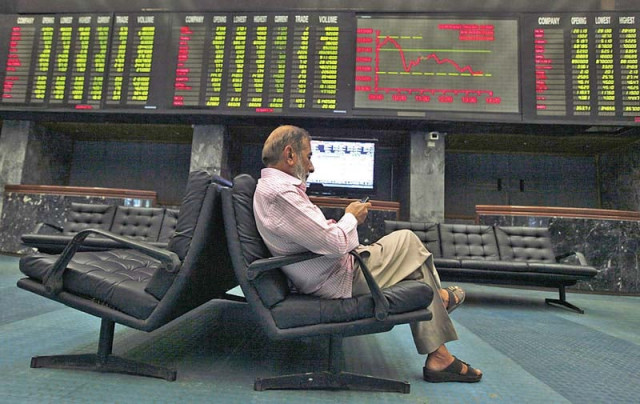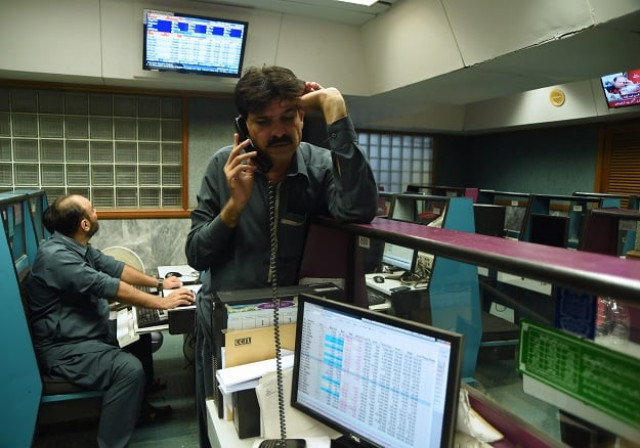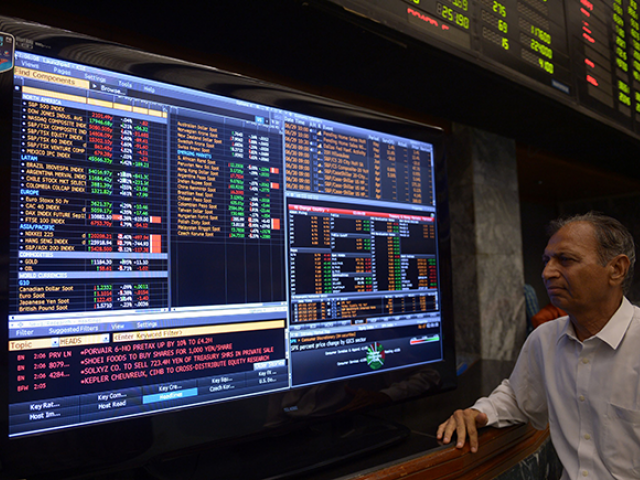Business
PSX plummets amid cautious investor sentiment | The Express Tribune

The Pakistan Stock Exchange (PSX) experienced a volatile session, with the KSE-100 Index fluctuating between gains and losses before ultimately closing lower at 163,806 points, representing a decline of 639 points, or 0.39%.
Investor sentiment remained cautious as participants opted to square off positions ahead of the weekend. Heavyweights such as MARI, UBL, HBL, POL, and ENGRO faced notable selling pressure, collectively dragging the index down by 381 points.
On the macroeconomic front, the Sensitive Price Index (SPI) for the week ended October 16, 2025, registered a 4.57% year-on-year increase and a 0.49% week-on-week rise, reflecting persistent inflationary pressures.
Also Read: SC says companies must pay their due share of super tax
A survey by Arif Habib Limited indicated a broad market consensus for a status quo stance ahead of the upcoming Monetary Policy Meeting on October 27, 2025, with 87.5% of respondents expecting the State Bank of Pakistan (SBP) to maintain the policy rate.
Despite the cautious tone, market activity remained vibrant, with 1.98 billion shares traded and an aggregate value of PKR 36.9 billion. WTL led the volume charts with an impressive 891.3 million shares, reflecting sustained retail participation.
On a weekly basis, the PSX closed in positive territory, gaining 708 points (+0.43%), with the benchmark KSE-100 opening at 161,402, touching a high of 167,562, and dipping to a low of 157,678 before stabilizing at 163,806.
PSX wrapped up the week just below the 165–170 consolidation zone, maintaining its cautious tone. The index is expected to continue with a cautious tone in the coming sessions, as investors await monetary cues and macro clarity before taking fresh positions, said Ali Najib, Deputy Head of Trading at Arif Habib Ltd.
Business
Credit Card Spends Ease In October As Point‑Of‑Sale Transactions Grow 22%

New Delhi: Credit card spending eased by Rs 2.5 billion in October to Rs 2,142 billion, a moderation of 1.1 per cent month‑on‑month but an increase of 6.1 per cent year‑on‑year, driven by a sharp shift toward point‑of‑sale transactions, a report said on Tuesday.
“The strong POS growth can likely be attributed to festive (Diwali) spending, whereas muted online spends are due to the elevated base of the previous month,” the report from Asit C. Mehta Investment Intermediates Limited said.
Point‑of‑sale transactions grew 22 per cent month‑on‑month and 11.4 per cent year‑on‑year, while online spending declined 12.7 per cent MoM and rose 2.7 per cent YoY. The top 10 banks accounted for 94 per cent of total spending, with HDFC Bank recording the highest MoM spending market share gain in October.
An increase of 6.7 per cent is seen in the total number of cards outstanding on a YoY basis, adding a total of 0.63 million cards, the report said. Transaction volumes saw a healthy growth of 4.6 per cent MoM and 19.2 per cent YoY. The YoY growth is lower than the historical average due to a high base last year.
Since volume growth outpaced spend growth, the average spend per transaction declined by 6 per cent MoM and 11 per cent YoY. With card issuance rising and overall spending remaining flat, the average spend per card declined 1.7 per cent MoM and 0.5 per cent YoY.
IndusInd Bank reported a steep 36 per cent MoM decline in average spend per card, due to a sharp fall of 34 per cent in its total spends. Among major banks, HDFC Bank led with 0.14 million new cards, followed by SBI (0.13mn), ICICI Bank (0.1mn), and Axis Bank (0.08mn). HDFC Bank reported the highest YoY gain of 1.12 per cent.
Business
Apartment rents drop further, with vacancies at record high

A version of this article first appeared in the CNBC Property Play newsletter with Diana Olick. Property Play covers new and evolving opportunities for the real estate investor, from individuals to venture capitalists, private equity funds, family offices, institutional investors and large public companies. Sign up to receive future editions, straight to your inbox.
A slew of new supply is still making its way through the multifamily housing market. That, coupled with weakening demand, especially from the youngest workers, is pushing vacancies up and rents down.
The national median rent for apartments fell 1% in November from October, and now stands at $1,367, according to Apartment List. It was the fourth consecutive month-over-month decline. Apartment rents are down 1.1% from November 2024 and have fallen 5.2% from their 2022 peak.
“Earlier this year, it appeared that annual growth was on track to flip positive for the first time since mid-2023; however, that rebound stalled out and reversed course during a particularly slow summer,” according to Apartment List researchers.
After hitting a record high for this index, which dates back to 2017, in October, the national multifamily vacancy rate remained at 7.2% in November.
The historic surge in multifamily construction over the past few years is now pulling back, but a good supply of new units is still coming online at a time of much weaker demand.
The fall historically sees the biggest slowdown in multifamily rents, but this year it’s even more pronounced. CoStar reported the biggest monthly drops in median rent it had seen in 15 years of tracking. The primary reason is that more young people are struggling to form new households.
“That 18- to 34-year-old group … I think it’s up to 32.5% of those now are living with family, and that’s the highest it’s been in a while,” said Grant Montgomery, CoStar’s national director of multifamily analytics. “I think it reflects high rental costs that have risen over the years, as well as the tougher job market for young folks just coming out of college.”
“That is where a lot of demand traditionally comes from, the core renter demand is from that sort of younger base,” he said.
The weakness is showing up in stocks of the major public apartment REITs. Names like AvalonBay, Equity Residential and Camden Property Trust are all down year to date.
Some markets are seeing rents drop faster than others, due to local economic factors. Las Vegas, for example, is experiencing slower tourism, which in turn hits jobs there. Boston has seen a decline in federal funding for biotech as well as a drop in foreign students for its colleges and universities; both are impacting its rental sector hard. Austin, Texas, is seeing the biggest hit to rents, thanks to still more construction of multifamily units.
While rents are softening nationally, and landlords are boosting concessions, renters are increasingly searching in more affordable markets.
Cincinnati was the market most searched for, followed by Atlanta and Kansas City, Missouri, according to a Yardi report that looked at where apartment hunters were active last summer, the traditionally busiest time for new leasing. St. Louis saw the biggest quarterly jump in tenant interest, and Washington, D.C., dropped from the top spot to No. 4.
“The Midwest, in particular, drew more attention than ever, signaling that many of its ‘hidden gem’ markets are no longer a secret,” according to the report, which found 11 of the top 30 cities for renter demand were in the Midwest.
Yardi also revised its expectations for 2026 supply, saying that while new supply will decline through 2027, a larger-than-expected under-construction pipeline caused it to increase its previous quarterly estimates for 2025 and 2026 by 6.8% and 2.5%, respectively.
As construction continues to slow into next year, the overall market should stabilize somewhat, according to the Apartment List report.
“That said, the supply boom still has a bit of runway remaining, and the demand outlook has begun to appear weaker amid a shaky labor market,” researchers wrote.
Business
India-Russia ties: Moscow signals readiness to fix trade deficit; energy, defence and new payment architecture on agenda – The Times of India

Russia on Tuesday said it is ready to address India’s concerns over the widening trade deficit and proposed building a framework to shield bilateral commerce from pressure by third countries. Kremlin spokesperson Dmitry Peskov, speaking ahead of President Vladimir Putin’s visit to New Delhi, said Moscow is also working to stabilise crude supplies after a brief dip linked to Western sanctions, according to PTI.Peskov told reporters during a video-streamed news conference that Friday’s summit between Putin and Prime Minister Narendra Modi will focus on strengthening trade, energy cooperation, small modular nuclear reactors and additional defence projects. Putin is scheduled to arrive on Thursday for the annual meeting.Russia signals efforts to ease trade deficitPeskov acknowledged India’s concern over the large trade gap and said Russia is keen to increase its imports from India. “There is a real imbalance in our trade. We know our Indian friends are concerned about that. We are jointly looking at the possibilities of increasing imports from India. We want to buy more from India,” he said.India’s purchases of Russian goods and services amount to around $ 65 billion, while Russia’s imports from India are around $ 5 billion.He also said Moscow is taking steps to ensure crude supplies remain stable despite the impact of Western restrictions. India’s purchase of Russian oil, he said, may dip only for a “very brief period.”Push for alternative payment systems and sanctions-proof tradePeskov urged the creation of an “architecture” to insulate India-Russia trade from geopolitical pressure. “We should create an architecture of our relationship that must be free of any influence coming from any third country,” he said. He stressed that bilateral trade must be protected from external pressure and that Russia rejects the use of the dollar-denominated global payment system as a “political tool.”He indicated that settlement through national currencies may feature in the Modi-Putin talks. “We understand the pressure on India,” he said, referring to the US.The visit comes at a tense moment in India-US ties, with Washington imposing a 50% tariff on Indian goods and an additional 25% levy linked to New Delhi’s procurement of Russian crude.Defence, nuclear cooperation and technology sharingPeskov highlighted joint production of the BrahMos missile system as a model for high-technology collaboration and said discussions may cover potential supplies of Su-57 fighter jets and additional S-400 air defence systems. He also said cooperation in small and medium nuclear reactors is expected to be part of the talks. Russia has experience producing these systems and is prepared to share the technology with India.On China, Peskov said Russia’s “limitless” partnership with Beijing does not diminish its willingness to deepen ties with India. “We are ready to go as far as India is ready,” he said, adding that Moscow respects India-China relations and hopes both sides resolve their issues to preserve global stability.Ukraine conflict, counter-terrorism and Afghanistan tiesPeskov welcomed recent US mediation efforts in the Ukraine conflict, calling them “very effective” and expressing hope for progress. He said the Russia-Ukraine war will be an important part of the Modi-Putin agenda. “Russia is open for peaceful negotiation; we have to reach our goals. We appreciate the position of India,” he said.He added that Russia is ready to work with India “to combat terrorism,” and said Moscow is strengthening its engagement with Afghanistan. “We’ll continue to develop our relationship with Afghanistan,” he noted.On overall ties, Peskov said Russia is proud to stand “shoulder-to-shoulder” with India during its period of historic growth.
-

 Sports1 week ago
Sports1 week agoWATCH: Ronaldo scores spectacular bicycle kick
-

 Entertainment1 week ago
Entertainment1 week agoWelcome to Derry’ episode 5 delivers shocking twist
-

 Politics1 week ago
Politics1 week agoWashington and Kyiv Stress Any Peace Deal Must Fully Respect Ukraine’s Sovereignty
-

 Business1 week ago
Business1 week agoKey economic data and trends that will shape Rachel Reeves’ Budget
-

 Tech2 days ago
Tech2 days agoGet Your Steps In From Your Home Office With This Walking Pad—On Sale This Week
-

 Politics1 week ago
Politics1 week ago53,000 Sikhs vote in Ottawa Khalistan Referendum amid Carney-Modi trade talks scrutiny
-

 Tech1 week ago
Tech1 week agoWake Up—the Best Black Friday Mattress Sales Are Here
-

 Entertainment2 days ago
Entertainment2 days agoSadie Sink talks about the future of Max in ‘Stranger Things’












